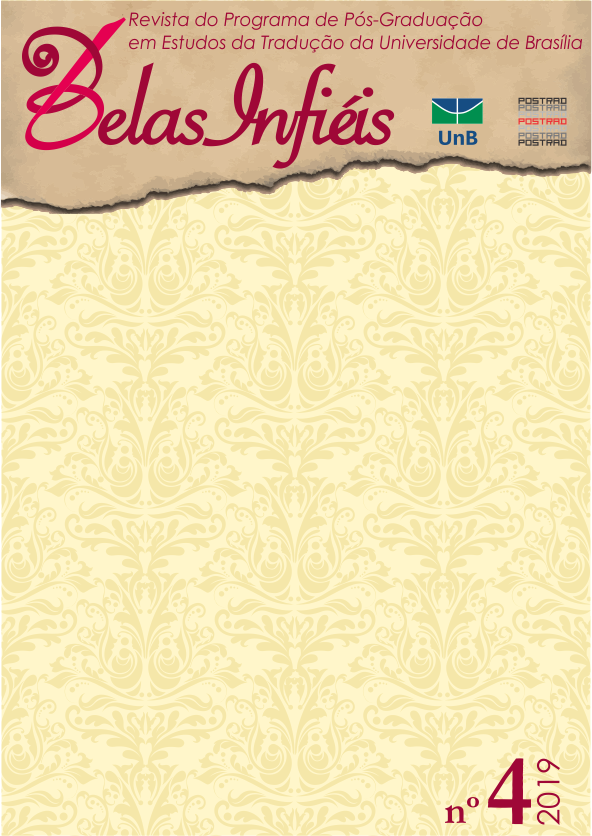Implicações da globalização e da padronização linguística nos padrões de legendagem e o dialeto visual como estratégia para legendar a variação linguística
DOI:
https://doi.org/10.26512/belasinfieis.v8.n4.2019.22986Palavras-chave:
Globalização. Padronização. Legendagem. Espanhol neutro. Dialeto visual.Resumo
Globalização e padronização caminham juntas. A padronização linguística é um elemento importante para garantir a unidade de uma língua e, no caso do espanhol, é uma característica fortemente presente nas políticas linguísticas e na consciência dos falantes. O s. XXI tem vivido uma mudança importante com a construção de uma nova política linguística pan-hispânica e o planejamento de uma norma pluricêntrica do espanhol na qual nenhuma variedade deve se impor sobre à s demais. Mas, apesar do discurso institucionalizado em favor da unidade do espanhol e de seu fortalecimento como língua de globalização, continuam sendo produzidas traduções diferentes para o espanhol peninsular e o americano, conhecido no meio da tradução como espanhol neutro: uma variedade que se propõe a evitar usos excessivamente localizados. Esta variedade, utilizada também nos noticiários e em algumas telenovelas produzidas para difusão internacional com a intenção de abranger o maior número de espectadores, surgiu nas comunidades da prática como uma construção a muitas mãos desenvolvida de maneira empírica por tradutores e comunicadores sem o amparo de uma padronização oficial. O espanhol neutro tem reconhecimento oficial em vários países, mas ainda apresenta lacunas importantes que precisam ser problematizadas. Além da padronização linguística, a globalização e os avanços tecnológicos têm provocado importantes mudanças nos padrões de legendagem existentes para as diferentes línguas. Este trabalho apresenta um breve histórico dessa evolução e analisa alguns exemplos de tradução para discutir as repercussões negativas que o excessivo apego à norma padrão e ao espanhol neutro pode ter no poder expressivo das legendas de filmes e séries, resultando numa linguagem asséptica que, além de apagar as marcas da oralidade, neutraliza traços dos personagens que dizem respeito a seu estado psicológico, idade, gênero e procedência geográfica e social. Também é trazida à tona a necessidade de um novo olhar para lidar com a legendagem de palavrões e de filmes multilíngues e, por fim, são exploradas as possibilidades criativas do dialeto visual como estratégia para legendar a variação linguística.
Downloads
Referências
ÁVILA, Raúl. Los medios de comunicación masiva y el español internacional. In: II CONGRESO INTERNACIONAL DE LA LENGUA ESPAÑOLA: EL IDIOMA ESPAÑOL EN LA SOCIEDAD DE LA INFORMACIÓN. Anais [...]. Valladolid, 2001. Disponível em: https://cvc.cervantes.es/obref/congresos/valladolid/ponencias/unidad_diversidad_del_espanol/1_la_norma_hispanica/avila_r.htm. Acesso em: 2 out. 2019.
BAKER, Mona. Translating dissent: Voices from and with the Egyptian revolution. Abingdon: Routledge, 2016.
BRISSET, Annie. A Sociocritique of Translation. Toronto: University of Toronto Press, 1996.
CABRERA INFANTE, Guillermo. Tres tristes tigres. Barcelona: Seix Barral, 1967.
DEMONTE BARRETO, Violeta. El español estándar (ab)suelto: algunos ejemplos del léxico y la gramática. In: CVC. II CONGRESO INTERNACIONAL DE LA LENGUA ESPAÑOLA: EL ESPAÑOL EN LA SOCIEDAD DE LA INFORMACIÓN. Anais [...]. Valladolid, 2001. Disponível em: https://cvc.cervantes.es/obref/congresos/valladolid/ponencias/unidad_diversidad_del_espanol/1_la_norma_hispanica/demonte_v.htm. Acesso em: 2 out. 2019.
DÃAZ CINTAS, Jorge. Teoría y práctica de la subtitulación: inglés / español. Barcelona: Ariel, 2003.
ERIKSEN, Thomas Hylland. Globalization: The Key Concepts. Oxford/New York: Berg,
ESQUEDA, Marileide Dias. O filme Tropa de Elite em espanhol: a questão da tradução dos palavrões. Abehache, ano 2, n. 3, p. 145-161, 2012.
GARCÃA CANCLINI, Néstor. Diferentes, desiguais e desconectados: mapas da interculturalidade (3. ed.). Traduzido por: Luiz Sérgio Henriques. Rio de Janeiro: UFRJ, 2004.
GOTTLIEB, Henrik. Subtitles and International Anglification. Nordic Journal of English Studies, Copenhagen, p. 229-230, 1998.
MATA, Patrícia Tavares da. Legendagem Ativista: a importância de marcar o socioleto no filme Catadores de História. Trabalho de Conclusão de Curso (Graduação) ”“ Departamento de Línguas Estrangeiras e Tradução. Universidade de Brasília, Brasília, 2018.
MORENO CABRERA, Juan Carlos. Prejuicios sobre el euskera. Nabarraldek argitaratua, 2006. Disponível em: http://www.nabarralde.com/es/archivo/ekarpenak/3094-juan-carlos-moreno-cabrera-prejuicios-sobre-el-euskera. Acesso em: 2 out. 2019.
MORENO FERNÁNDEZ, Francisco. Sociolingüística de la globalización. In: Olímpio de Oliveira Silva, M. E; Penadés Martínez, M. I. (eds.). Investigaciones actuales en Lingüística. Vol. I: Sobre la Lingüística y sus disciplinas. Alcalá de Henares: Servicio de Publicaciones de la Universidad de Alcalá, 2017, p.118-135.
MORTADA, Leil-Zahra. Translation and solidarity in Words of Women from the Egyptian Revolution. In: BAKER, Mona. Translating dissent voices from and with the Egyptian revolution. Abingdon: Routledge, 2016. p. 88-96.
NETFLIX. Brazilian Portuguese Timed Text Style Guide. Disponível em: https://partnerhelp.netflixstudios.com/hc/en-us/articles/215600497-Brazilian-Portuguese-Timed-Text-Style-Guide. Acesso em: 2 out. 2019.
NETFLIX. Castilian and Latin American Spanish Timed Text Style Guide. Disponível em: https://partnerhelp.netflixstudios.com/hc/en-us/articles/217349997-Castilian-Latin-American-Spanish-Timed-Text-Style-Guide. Acesso em: 2 out. 2019.
NUESSEL, Frank. Eye Dialect in Spanish: Some Pedagogical Applications. Hispania: A Journal Devoted to the Teaching of Spanish and Portuguese, 65(3), p. 346-51, 1982.
ORTEGA, Julio. La contemplación y la fiesta. Caracas: Monte Ávila Editores. 1969.
PEDERSEN, Jan. From old tricks to Netflix: How local are interlingual subtitling norms for streamed television? Journal of Audiovisual Translation, 1(1), p. 81-100, 2018.
PINTO, Sara Ramos. How important is the way you say it? A discussion on the translation of linguistic varieties. Target 21, n. 2, p. 289-307, 2009.
SCANDURA, Gabriela. El español neutro para el doblaje: mitos y realidades. Trabalho apresentado no Congreso Hispanoamericano de Traducción Audiovisual. Buenos Aires, 2018.
SILVA, Janailton Mick Vitor da. Que espaço a legendista ocupa? Um estudo sobre estilo do tradutor. 2018. 176 f. Dissertação (Mestrado em Estudos da Tradução) ”“ Departamento de Línguas Estrangeiras e Tradução. Universidade de Brasília, Brasília, 2018.
Referências Audiovisuais
TROPA de Elite. Direção: José Padilha. 2007. 1 filme (118 min). DVD.
CATADORES de História. Direção: Tânia Quaresma. 2015. 1 filme (75 min).
DÃAS: ¿Cómo es vivir y trabajar en la basura? Direção: Catalina Castro, 2017. (61 min). Disponível em: https://www.youtube.com/watch?v=AoXsUWNTF_M. Acesso em: 3 out. 2019.
Downloads
Publicado
Como Citar
Edição
Seção
Licença
Dado ao acesso público desta revista, os textos são de uso gratuito, com obrigatoriedade de reconhecimento da autoria original e da publicação inicial nesta revista
A revista permitirá o uso dos trabalhos publicados para fins não comerciais, incluindo direito de enviar o trabalho para bases de dados de acesso público. As contribuições publicadas são de total e exclusiva responsabilidade dos autores.
Os autores, ao submeterem trabalhos para serem avaliados pela revista Belas Infiéis, mantêm os direitos autorais e concedem à revista o direito de primeira publicação, sendo o trabalho licenciado sob a Creative Commons Attribution License Atribuição 4.0 Internacional (CC BY 4.0).



















